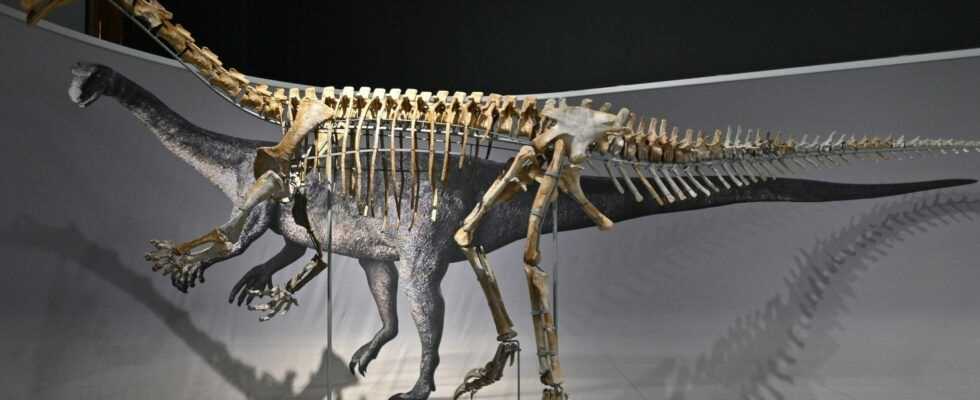After around 15,000 working hours, the Natural History Museum Vienna (NHM) can come up with a new dinosaur skeleton. At the end of the extensive restoration, the remains of a 210 million year old plate dinosaur, which the Sauriermuseum Frick (Switzerland) received as a self-assembly kit, will be on display from October 20th as part of the special show “KinoSaurier”. Around 40 percent of the bones come from 3D printing – but this is not apparent to the naked eye.
Plateosaurus trossingensis was a herbivore up to eight meters long that lived during the Triassic period. It is considered to be the forerunner of the giant sauropods, the largest land animals that ever colonized the earth. With its appearance around 235 million years ago it is one of the earliest representatives of the dinosaurs. Bones were found in Switzerland and Germany as early as the 19th century.
310 individual bones in six-meter dinosaur
One of the most important sites of dinosaurs from the Triassic period in Europe is located in the area of today’s municipality of Frick in the Swiss canton of Aargau. About three years ago, the NHM was able to look forward to the permanent loan of the remains of a 210 million year old representative of the plateosaurs. The scientists even received the remains of two individuals to make up for the lack of bones. Ultimately, they put together an animal almost six meters long, consisting of 310 individual bones, and presented on Wednesday.
In 2018, they received many stone packages from Switzerland containing the remains of the two animals. “At the beginning it was by no means foreseeable whether we would be able to build the skeleton so beautifully,” explained the head of the geological and palaeontological department at the NHM, Mathias Harzhauser, in an interview with the APA. The majority of the bones, which will soon be accessible to the public, come from an animal, only eight bones were borrowed from the second former herbivore. At least 39 percent of the remains were, for example, deformed in such a way that they could not be inserted into the newly prepared skeleton or they were completely missing. They were therefore specifically produced using 3D printing technology and then painted in such a way that they can hardly be distinguished from the real bones. In the exhibition, however, a panel will show which remains are authentic and which are from the 21st century.
61 percent original bones
61 percent original bones “is really very good for an entire dinosaur skeleton. We’re pretty much at the top of that, ”said Harzhauser. The entire process was scientifically accompanied in the form of several papers that are still awaiting publication. According to recent findings, it is assumed that the plateosaurs were mostly on their hind legs and stretched for leaves. But they could also walk on four legs, says Harzhauser: “The long tail served as a balancing bar.”
The animal may have got stuck in the mud an unimaginably long time ago. The lower dinosaur parts are therefore better preserved than the upper areas. The head was then probably carried off by small predatory dinosaurs. The fact that other animals tampered with the now Viennese dinosaur can be traced back to a 17 millimeter large, broken tooth of a robber. The skull replacement is therefore a cast of a specimen from a Stuttgart museum.
Age and size known, Gender not
One does not know whether the dinosaur was a female or a male. “But we know that it was around 20 years old, that it weighed around 1.5 tons and was 5.8 meters long,” says the paleontologist. The structure turned out to be anything but trivial, because a holder had to be made for each individual bone. “These bones shouldn’t hang. They have to be supported, otherwise they would break, ”said Harzhauser. Ultimately, due to the high level of effort involved, it is an “expensive gift” from Switzerland, but “on balance a sensation”.
From October 20th, the new plateosaur will be one of the highlights of the special exhibition “KinoSaurier. Imagination and Research ”(until April 18, 2022). In cooperation with the Hanover State Museum, they show how the extinct giant lizards are portrayed on film and television. For the director general of the NHM, Katrin Vohland, it is “wonderful that we actually have an original from Europe. Originals are simply something completely different from plastic dinosaurs or 3D printouts. ”In the new exhibition, the plateosaurs will therefore be juxtaposed with pop-cultural representations.
After the special show, the plateosaur itself will move to the permanent exhibition in the dinosaur hall (hall 8). To do this, however, a large plaster cast skeleton has to give way, which, according to Harzhauser, “is not very attractive. I will be able to part with it very easily, ”said the scientist.
